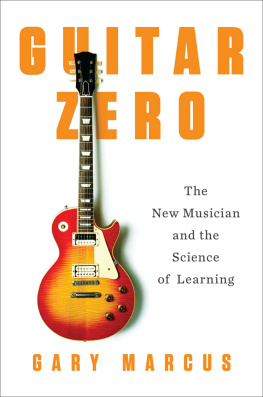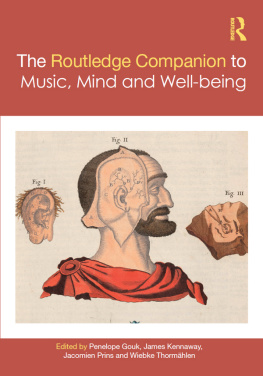The Origins of Musicality
edited by Henkjan Honing
The MIT Press
Cambridge, Massachusetts
London, England
2018 Massachusetts Institute of Technology
All rights reserved. No part of this book may be reproduced in any form by any electronic or mechanical means (including photocopying, recording, or information storage and retrieval) without permission in writing from the publisher.
This book was set in Syntax LT Std and Times New Roman by Toppan Best-set Premedia Limited. Printed and bound in the United States of America.
Library of Congress Cataloging-in-Publication Data
Names: Honing, Henkjan.
Title: The origins of musicality / edited by Henkjan Honing ; foreword by W. Tecumseh Fitch.
Description: Cambridge, MA : MIT Press, [2018] | Includes bibliographical references and index.
Identifiers: LCCN 2017033345 | ISBN 9780262037457 (hardcover : alk. paper)
eISBN 9780262344531
Subjects: LCSH: Music--Origin. | Musical ability.
Classification: LCC ML3800 .O744 2018 | DDC 781.1/1dc23 LC record available at https://lccn.loc.gov/2017033345
ePub Version 1.0
Foreword
The past two decades have been an exciting period for those interested in the cognitive and biological underpinnings of human musicalityan excitement well captured by the chapters in this book. The years since 2000 have witnessed increasing interdisciplinary synergy among musicology, ethnomusicology, psychology, neuroscience, and biology, leading to a nascent field of biomusicology that spans all of these disciplines. The chapters in this book, by leading international experts in these fields, offer an up-to-date snapshot of this exciting and broad field of scientific research.
A fundamental insight helping to drive this progress, driven largely by work in the psychology and neuroscience of music, has been the increasing realization that everyone is a skilled and sophisticated musical listener, even those who consider themselves to be unmusical or do not themselves produce music. In fact, abundant research now demonstrates that even musically untrained individuals have detailed, implicit knowledge of the musical forms and styles of their culture. In the same way that we all unconsciously know the structure and rules of our native language even if we cannot express them explicitly, we all have an implicit understanding of the melodic, rhythmic, and harmonic regularities of our cultures musics. Musicalitythe underlying capacity to acquire this knowledgeis thus part of our universal birthright as human beings. This realization has fueled a welcome extension of empirical research beyond the confines of traditional Western art music to include not just the art music of many other cultures, but also popular folk and dance music and, indeed, an increasing willingness to include dance itself as one important facet of human musicality.
Progress in understanding human musicality has been made on all fronts. Perhaps the most striking has been the meteoric rise of neuroscientific investigations of music, driven by the phenomenal increase in the power and availability of neuroimaging methods. Although the psychology of music has long been an active and sophisticated subfield, it has recently extended its scope from adults into childhood and infancy to show that even newborn infants are musically sensitive and rapidly develop expertise in their cultures musics in the first few years of life. Ethnomusicologists have gradually overcome a nearly sixty-year aversion to comparing the musics of different cultures (a pause broken only by Alan Lomaxs groundbreaking cantometrics research in the 1970s) and resumed the search for characteristics of human music that are universal, or nearly soan important foundation for any biological characterization of human musicality.
From my viewpoint as a biologist, investigations of animal analogues to human music have been particularly exciting as an increasing number of researchers have embraced an explicitly comparative approach to understanding the biological basis and evolutionary history of musicality. This line of research has revealed detailed commonalities of bird or whale song with our own music (in this case, convergently evolved), as well as some specific homologs such as the drumming behavior regularly engaged in by our nearest relatives, the chimpanzees and gorillas. This comparative research shows that although music itself may be specifically human, some of the fundamental mechanisms that underlie human musicality are shared with other species.
This book was born at a week-long international workshop on the cognitive and biological basis of musicality organized by Henkjan Honing, held in Leiden at the Lorentz Center in 2014, a workshop I was privileged to attend. The remarkable open-minded, collegial, and fearlessly interdisciplinary atmosphere that developed at this workshop is something I will never forget. This workshop led to a series of articles published in a special issue of Philosophical Transactions of the Royal Society in 2015. Most of the chapters in this book are reworked and revised versions of those articles, updated to reflect the latest research. Readers eager to learn more about human musicality and its biological basis will find no better starting point than this book.
W. Tecumseh Fitch
Vienna, April 2017
Preface
Why do we have music? What is music for, and why does every human culture have it? Is it a uniquely human capability, as language is? Or are some of its core components also present in nonhuman animals? And what biological and cognitive mechanisms are essential for perceiving, appreciating, and making music?
The search for a possible answer to these and other questions forms the backdrop of this book that brings together a collection of papers written by contributors to an interdisciplinary workshop, What Makes Us Musical Animals? Cognition, Biology and the Origins of Musicality, held at the Lorentz Center, Leiden, the Netherlands, April 711, 2014. The workshop was made possible through a generous Distinguished Lorentz Fellowship granted to me by the Netherlands Institute for Advanced Study in the Humanities and Social Sciences (NIAS) and the Lorentz Center for the Sciences. During this workshop, it became clear that reframing the empirical evidence from a variety of fields and proposing a research agenda on musicality were both important and timely. Moreover, the twenty-three contributing experts from a wide range of disciplines (cognitive biology, cognitive neuroscience, neurobiology, animal cognition, ethnomusicology, molecular genetics, anthropology, developmental psychology, and computational cognition) agreed on a list of key questions for a future agenda on musicality, providing the momentum for this book (see ).
Together the chapters set a research agenda for the study of musicality in the years to come, an endeavor that is multidisciplinary, as is the background of the authors. The topics of the fourteen, mostly coauthored chapters resulted from a bottom-up selection process during the Lorentz workshop, prompted by a series of position statements and reviews. These topics formed the basis of working sessions in which the key ingredients of the chapters were formulated.
The immediate outcome of the workshop was published in a theme issue on musicality in Philosophical Transactions of the Royal Society B, coedited with Carel ten Cate, Isabelle Peretz, and Sandra Trehub (). This book includes, next to updated and extended versions of the original papers, new theoretical material, novel empirical results, as well as a historical chapter that positions these recent developments in the relatively long history of studying the origins of musicality. The chapters are grouped in four parts. Part I presents an outline of a research program on musicality and discusses the pitfalls and prospects of studying the evolution of music. Part II consists of four position statements on the origins of musicality. Part III presents five reviews on the origins of musicality from the perspective of anthropology, (ethno)musicology, paleontology, behavioral biology, cognitive neuroscience, neurobiology, and genetics. The chapters in part IV review the computational modeling of animal song and creativity, relating it to large body of empirical work from the field of biology. This is complemented by a chapter on affect in relation to behavioral biology. The book closes with a case study on the history of musicality research.





